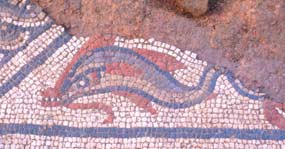Lopen Roman Mosaic facts for kids
The Lopen Roman Mosaic is a fantastic ancient floor artwork from the time of the Romans. It was likely part of a grand Roman villa (a large country house) located in the small village of Lopen, in Somerset, England. This amazing discovery helps us learn more about what life was like in Britain almost 2,000 years ago!
Contents
The Lopen Roman Mosaic
This incredible mosaic is one of the most important Roman finds in Britain. It gives us a peek into the luxurious homes of wealthy Romans who lived here long ago.
An Amazing Discovery
The Discovery Story
The mosaic was first found in 2001 by a man named George Caton. He was operating a mechanical digger when he noticed tiny, colorful stone cubes. These little cubes were actually part of a huge Roman floor! It turned out to be the floor of a Roman villa with eight rooms. This mosaic is the biggest Roman mosaic ever found in Britain!
Uncovering Ancient Art
Protecting the Past
After George's discovery, experts from English Heritage used special cameras to map the mosaic. Then, archaeologists from Somerset County Council took charge of the dig. They carefully uncovered and recorded the mosaic in just three weeks. To keep it safe, it was then covered with sand and soil. This method helps preserve ancient sites for future study. The hard work was recognized with a special award in 2002. It was called the Tarmac Finders Award, given to non-professionals at the British Archaeological Awards.
Reusing Ancient Materials
The stones used to make the mosaic came from the local hills. They are a type of rock called Blue Lias. Small pieces of the mosaic that were found in the surrounding soil were used to create a new mosaic. This new artwork includes a picture of a dolphin. It was made using the same methods that Romans would have used. You can now see this new mosaic displayed in All Saints Church.
What the Mosaic Looks Like
The main mosaic is almost 7 meters (about 23 feet) square. It has a very detailed geometric design. This means it uses lots of shapes and patterns. It also includes some stylized pictures, like leaves, cups, and even dolphins.
A Special Design
Archaeologists believe this mosaic was probably made by a special group of artists. They might have been based in Cirencester, another important Roman town. This group is known as the "Saltire school." They got this name because they often used "saltires" in their designs. A saltire is a diagonal cross shape, like the letter 'X'. You can see this design in the Lopen mosaic.
Roman Rooms
Another mosaic was found in a room next to the main one. This second mosaic was about 4.5 meters (about 15 feet) square. The walls of these rooms were probably painted with colorful designs on plaster. However, no traces of these paintings have survived here. The main room with the large mosaic was likely used as a dining room. Imagine eating a meal in such a beautifully decorated space!


